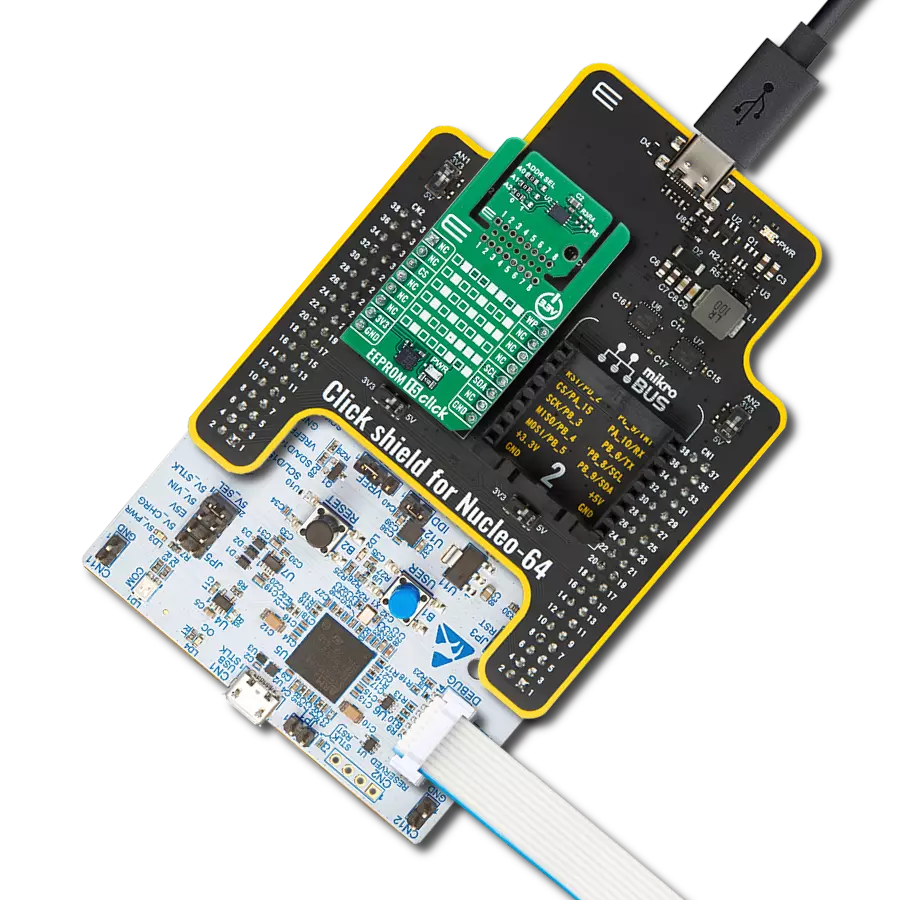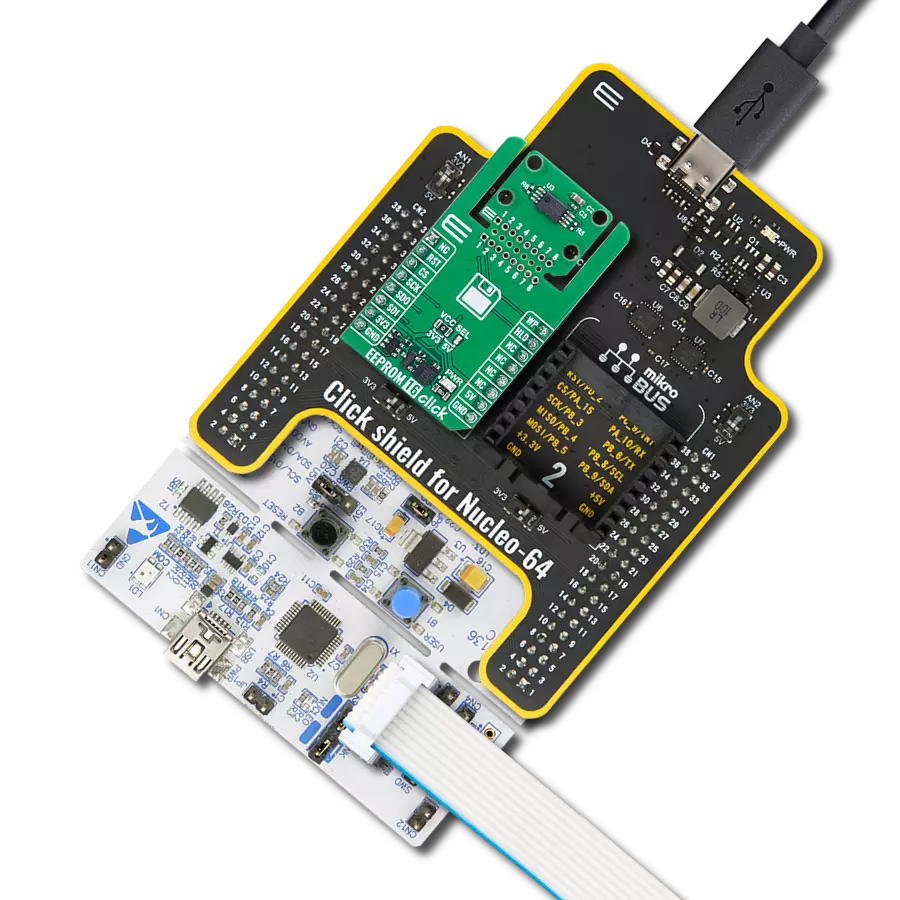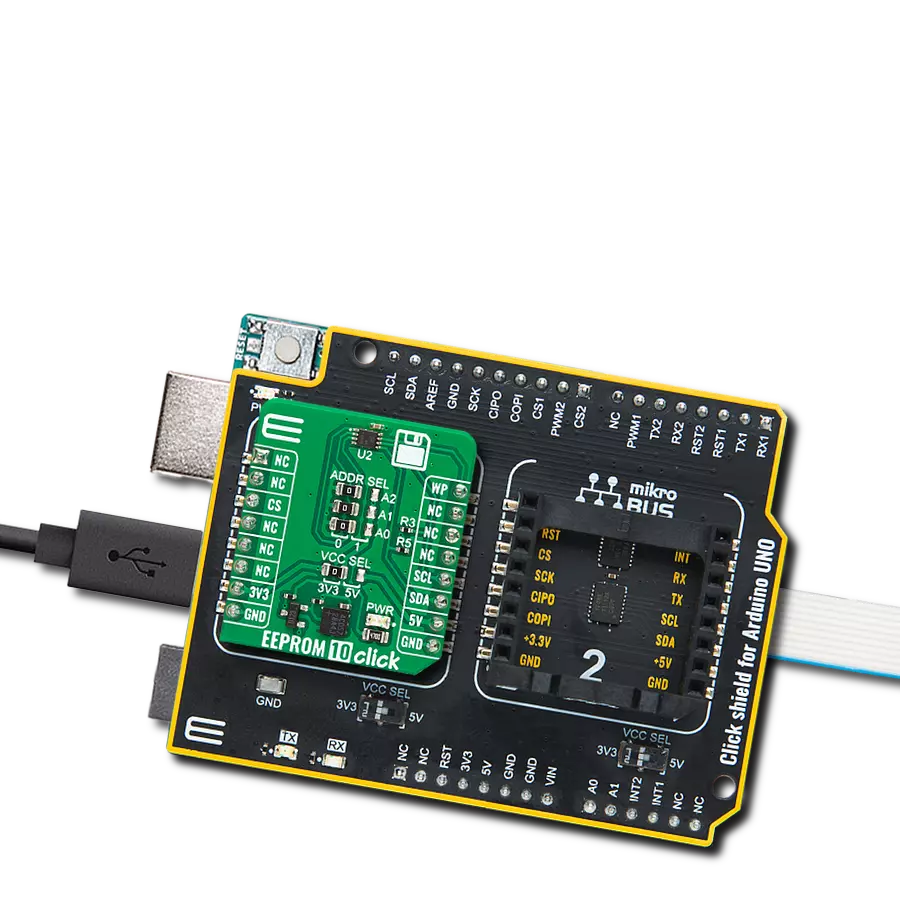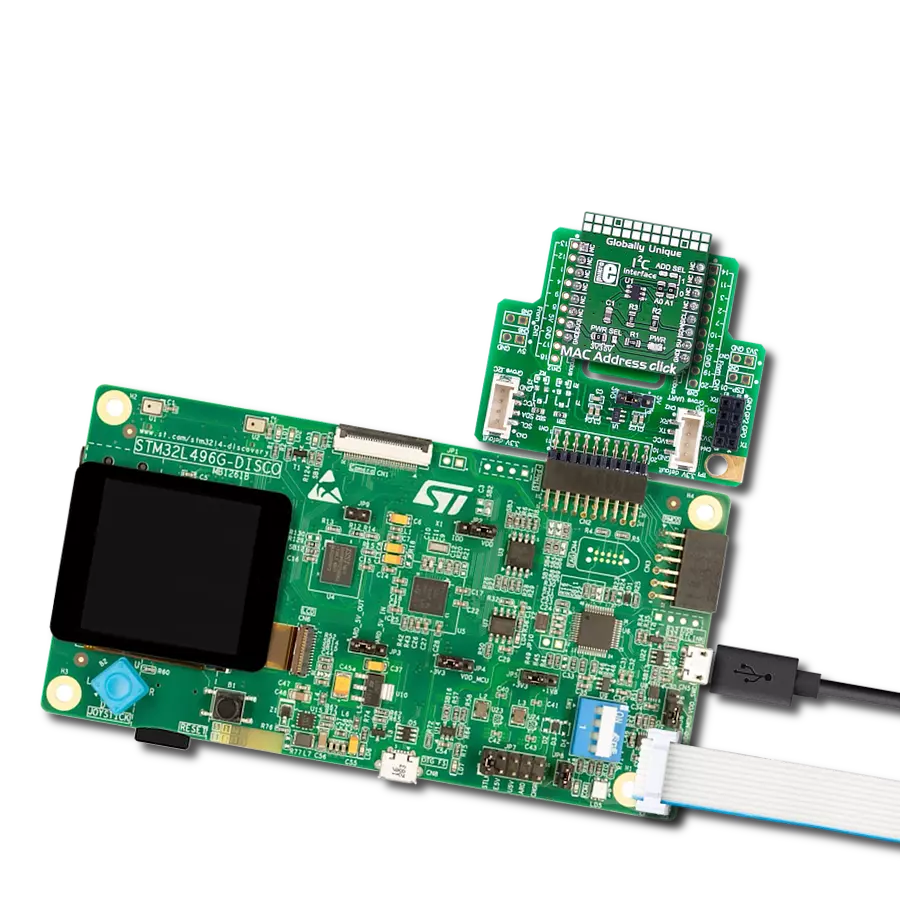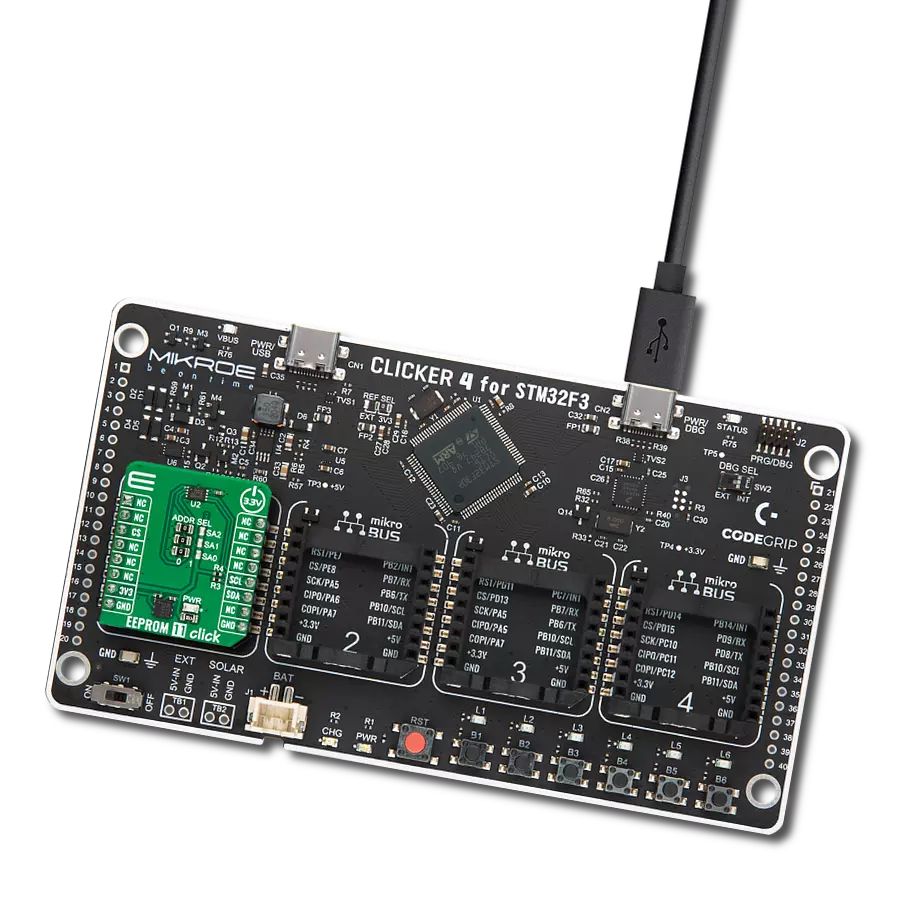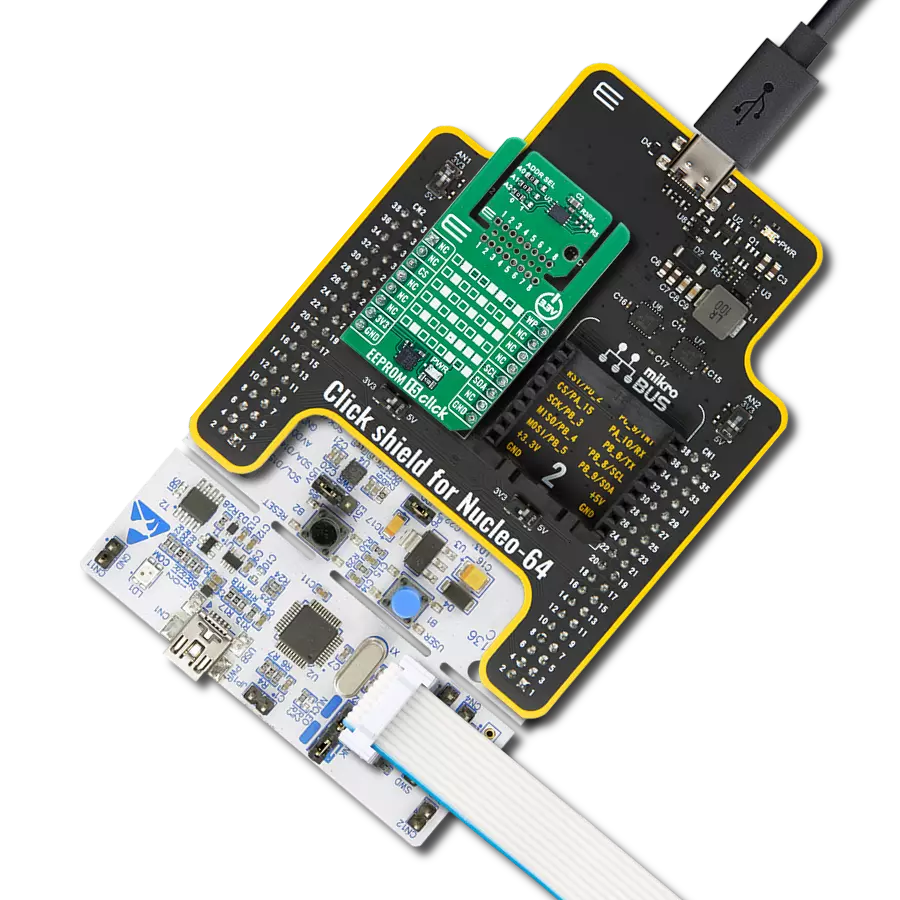Amplify your data storage prowess through our state-of-the-art solution, showcasing dual EEPROM memory with an impressive 4Mb capacity
A
A
Hardware Overview
How does it work?
Dual EE Click is based on two AT24CM02, an I2C serial EEPROM from Microchip. This means the ICs can have a different I2C address so that users can choose which one they would like to use at a particular time. This is achieved by wiring the I2C address selection lines from one of the ICs to the VCC while the other IC is wired to the GND. Given this feature, it is important to note that this click board has 4MB of memory. This Click board™ uses the I2C communication protocol. Therefore, the host MCU initiates every data transaction event, transmitting the I2C START condition, followed by the AT24CM02 device ID byte. Upon receiving the device ID byte, the AT24CM02 IC expects two more address bytes, completing the 18-bit address word. The EEPROM density is usually expressed in bits, so exactly 2.097.152 bits are organized in units or words of 8 bits, which gives 262.144 bytes of data memory. Furthermore, the EEPROM is
organized into so-called pages. One page holds 256 bytes, and there are 1024 pages (1024 pages x 256 bytes = 262.144 bytes total). Given that this click contains two EEPROM Ics, this Click board™ has twice as much memory, equaling 4 MB. Having insight into how the memory cells are organized is important for Write and Erase operations. The I2C pins are routed to the mikroBUS™, making communication easy and straightforward. Both 100KHz and 400KHz transfer speeds are supported by the AT24CM02 IC and the 1MHz Fast Mode Plus (FM+) I2C communication for the MCUs with I2C modules that can support that speed. One of the key features of the AT24CM02 IC is the Error Detection and Correction scheme (EDC), which allows error correction by utilizing six additional bits internally assigned to a group of four bytes. This protection scheme can correct some bit errors, staying transparent to the end
user. The bit comparison and error correction are done internally. The Dual EE Click board™ offers a selection between 3.3V and 5V operation, with the onboard SMD jumper labeled PWR SEL. This allows both 3.3V and 5V MCUs to be interfaced with this Click board™. The attached device datasheet contains an in-depth explanation of all the mentioned functions. However, Mikroe provides a library with functions that make the final code clean and readable, simplifying working with this device. These functions internally employ the aforementioned communication mechanism and expose only a simple and clean interface to the user. The provided example code demonstrates the functionality of these functions. It can be used as a reference point for custom development.
Features overview
Development board
PIC18F57Q43 Curiosity Nano evaluation kit is a cutting-edge hardware platform designed to evaluate microcontrollers within the PIC18-Q43 family. Central to its design is the inclusion of the powerful PIC18F57Q43 microcontroller (MCU), offering advanced functionalities and robust performance. Key features of this evaluation kit include a yellow user LED and a responsive
mechanical user switch, providing seamless interaction and testing. The provision for a 32.768kHz crystal footprint ensures precision timing capabilities. With an onboard debugger boasting a green power and status LED, programming and debugging become intuitive and efficient. Further enhancing its utility is the Virtual serial port (CDC) and a debug GPIO channel (DGI
GPIO), offering extensive connectivity options. Powered via USB, this kit boasts an adjustable target voltage feature facilitated by the MIC5353 LDO regulator, ensuring stable operation with an output voltage ranging from 1.8V to 5.1V, with a maximum output current of 500mA, subject to ambient temperature and voltage constraints.
Microcontroller Overview
MCU Card / MCU
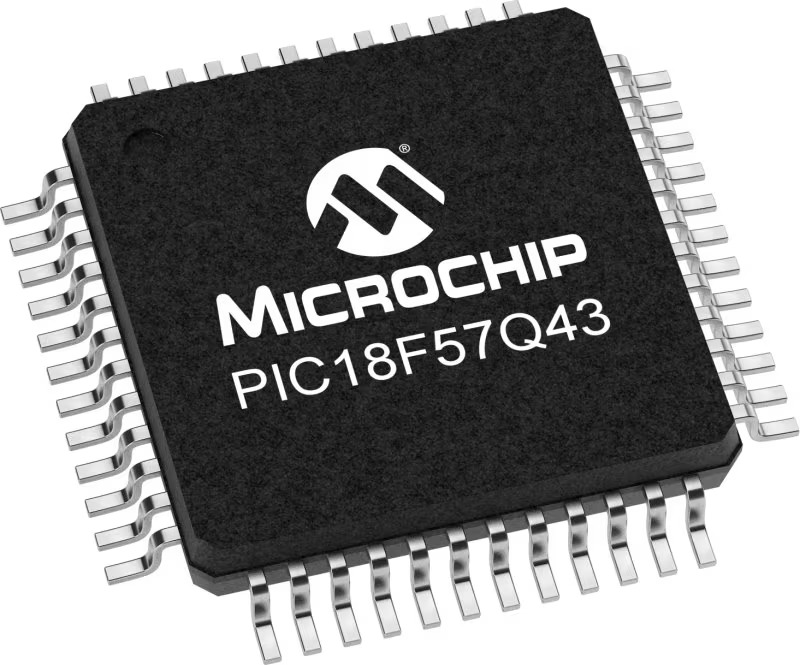
Architecture
PIC
MCU Memory (KB)
128
Silicon Vendor
Microchip
Pin count
48
RAM (Bytes)
8196
You complete me!
Accessories
Curiosity Nano Base for Click boards is a versatile hardware extension platform created to streamline the integration between Curiosity Nano kits and extension boards, tailored explicitly for the mikroBUS™-standardized Click boards and Xplained Pro extension boards. This innovative base board (shield) offers seamless connectivity and expansion possibilities, simplifying experimentation and development. Key features include USB power compatibility from the Curiosity Nano kit, alongside an alternative external power input option for enhanced flexibility. The onboard Li-Ion/LiPo charger and management circuit ensure smooth operation for battery-powered applications, simplifying usage and management. Moreover, the base incorporates a fixed 3.3V PSU dedicated to target and mikroBUS™ power rails, alongside a fixed 5.0V boost converter catering to 5V power rails of mikroBUS™ sockets, providing stable power delivery for various connected devices.
Used MCU Pins
mikroBUS™ mapper
Take a closer look
Click board™ Schematic

Step by step
Project assembly
Track your results in real time
Application Output
1. Application Output - In Debug mode, the 'Application Output' window enables real-time data monitoring, offering direct insight into execution results. Ensure proper data display by configuring the environment correctly using the provided tutorial.

2. UART Terminal - Use the UART Terminal to monitor data transmission via a USB to UART converter, allowing direct communication between the Click board™ and your development system. Configure the baud rate and other serial settings according to your project's requirements to ensure proper functionality. For step-by-step setup instructions, refer to the provided tutorial.

3. Plot Output - The Plot feature offers a powerful way to visualize real-time sensor data, enabling trend analysis, debugging, and comparison of multiple data points. To set it up correctly, follow the provided tutorial, which includes a step-by-step example of using the Plot feature to display Click board™ readings. To use the Plot feature in your code, use the function: plot(*insert_graph_name*, variable_name);. This is a general format, and it is up to the user to replace 'insert_graph_name' with the actual graph name and 'variable_name' with the parameter to be displayed.

Software Support
Library Description
This library contains API for Dual EE Click driver.
Key functions:
dualee_read- Generic write data functiondualee_write- Generic write data function
Open Source
Code example
The complete application code and a ready-to-use project are available through the NECTO Studio Package Manager for direct installation in the NECTO Studio. The application code can also be found on the MIKROE GitHub account.
/*!
* \file
* \brief DualEE Click example
*
* # Description
* This application writes data in memory and reads data from memory
*
* The demo application is composed of two sections :
*
* ## Application Init
* Initializes device init
*
* ## Application Task
* Reads your command and then execute it
*
* \author MikroE Team
*
*/
// ------------------------------------------------------------------- INCLUDES
#include "board.h"
#include "log.h"
#include "dualee.h"
// ------------------------------------------------------------------ VARIABLES
static dualee_t dualee;
static log_t logger;
static uint32_t page_address = 0x00000000;
static uint8_t write_data[ 7 ] = { 'M', 'i', 'k', 'r', 'o', 'E', 0 };
// ------------------------------------------------------ APPLICATION FUNCTIONS
void application_init ( void )
{
log_cfg_t log_cfg;
dualee_cfg_t cfg;
/**
* Logger initialization.
* Default baud rate: 115200
* Default log level: LOG_LEVEL_DEBUG
* @note If USB_UART_RX and USB_UART_TX
* are defined as HAL_PIN_NC, you will
* need to define them manually for log to work.
* See @b LOG_MAP_USB_UART macro definition for detailed explanation.
*/
LOG_MAP_USB_UART( log_cfg );
log_init( &logger, &log_cfg );
log_info( &logger, "---- Application Init ----" );
// Click initialization.
dualee_cfg_setup( &cfg );
DUALEE_MAP_MIKROBUS( cfg, MIKROBUS_1 );
dualee_init( &dualee, &cfg );
log_printf( &logger, "*********** APPLICATION INIT ***********\r\n" );
Delay_ms ( 100 );
}
void application_task ( )
{
uint8_t write_dual;
uint8_t read_dual;
char demo_text[ 255 ];
log_printf( &logger, "Writing data [MikroE]....\r\n" );
write_dual = dualee_write( &dualee, page_address, write_data, 7 );
if ( write_dual == DUALEE_ERROR_RW )
{
log_printf( &logger, "Error writing data!!!\r\n" );
Delay_ms ( 1000 );
return;
}
Delay_ms ( 100 );
log_printf( &logger, "Reading data...\r\n" );
read_dual = dualee_read( &dualee, page_address, demo_text, 7 );
if ( read_dual == 0 )
{
log_printf( &logger, "Error reading data!!!\r\n" );
Delay_ms ( 1000 );
return;
}
Delay_ms ( 100 );
log_printf( &logger, "Data from read page is: %s \r\n", demo_text );
log_printf( &logger, "__________________________________\r\n" );
Delay_ms ( 1000 );
}
int main ( void )
{
/* Do not remove this line or clock might not be set correctly. */
#ifdef PREINIT_SUPPORTED
preinit();
#endif
application_init( );
for ( ; ; )
{
application_task( );
}
return 0;
}
// ------------------------------------------------------------------------ END
Additional Support
Resources
Category:EEPROM




















